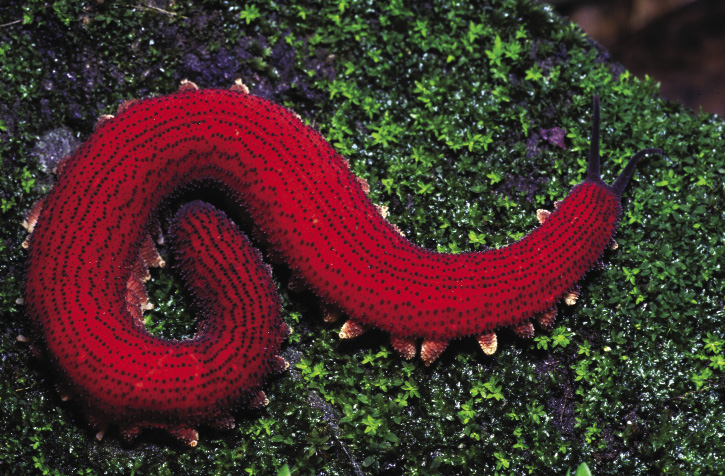
The power of short lectures to improve support for
biodiversity conservation of unpopular organisms:
an experiment with worms
Julián Monge-Nájera
Laboratorio de Ecología Urbana, Vicerrectoría de Investigación, UNED, 2050 San José, Costa Rica; julianmonge@gmail.com
Received 24-X-2016 • Corrected 12-xi-2016 • Accepted 12-xii-2016
ABSTRACT: Public opinion is important in obtaining support for the conservation of biodiversity, and invertebrates have a “public relations problem” because -for reasons that are both cultural and biological- they are poorly known and often unpopular. In this article I present the results of an experiment on the power of a short lecture to improve attitude towards invertebrates, using the case of velvet worms. Velvet worms are “living fossils” that have inspired a wide range of cultural expressions, probably because of the adhesive net they use to capture prey. For the experiment, a group of 141 Costa Ricans, aged 10 to 58 years old, rated their reaction to a color photograph of Epiperipatus biolleyi, a Costa Rican species of velvet worm, before and after a five-minute lecture about the natural history of the worm. Even before the treatment, most of the respondents had a correct idea of the animal’s anatomy (84%); supported the use of public funds to conserve it (71%); and more than half perceived the worm in a positive way (58%). They stated that they were willing to donate a mean of US$7,00 from their own pocket for the worm’s protection (six times more if they had university education); and were less likely to reject the worm if they kept pets at home. Gender, age and education did not have any effect on most variables of attitude and knowledge. Compared with the control group, the group that received the lecture had a 17% improvement in attitude. The Costa Rican educational system, focused on nature and its conservation, can explain the generally good attitude and knowledge of invertebrates found in this study; and a five-minute natural history lecture can produce a significant improvement in perception of an animal that is generally unattractive: a worm.
Key words: attitude towards invertebrates, quantitative effect of education, conservation of biodiversity, tropical worms, Epiperipatus biolleyi.
In a time when ecosystems are affected by a variety of phenomena such as loss of biodiversity and global climate change, public opinion becomes increasingly important because it affects how politics and conservation interact on a daily basis. In countries like Costa Rica, where conservation is centered on ecosystems, public perception of individual species is irrelevant, but in much of the world, flag species are important and invertebrates in general are at a disadvantage when compared with charismatic vertebrates such as the panda (e.g. Batt, 2009; Kilic, 2013).
The causes of the public rejection of invertebrates are both cultural and biological, and are largely influenced by individual variation (Prokop & Francovicova, 2013). For example, a study with European children found that those with several pets at home knew more about invertebrates than those with only one or with no pets; and even though boys knew more about invertebrates and girls were more negative towards dangerous animals, both genders were equally ignorant about invertebrate anatomy (Prokop, Prokop & Tunnicliffe, 2008; Prokop & Tunnicliffe, 2009; Kilic, 2013).
Despite the relatively large number of studies on attitudes towards other animals, including invertebrates, the literature is strongly biased towards Europe, with few studies from Asia, Africa and Latin America, for which only a few studies are available covering Mexico, Costa Rica and Brazil. Mexican school children are as negative towards spiders as English children, but they are justifiably more worried about poisonous species (Barraza, 2015). When Germany and Costa Rica were compared, Costa Rican schoolchildren consider invertebrates more interesting, valuable, and dangerous (Drissner, Simonte & Hille, 2016).
Amazonian school children share a negative attitude towards scorpions but there is a gender difference: boys are more interested than girls in learning about scorpions (Pontes-da-Silva, Tinoco Pacheco, Costa Lima Pequeno, Franklin, & Kaefer, 2016).
Education has the potential of reducing the generalized rejection of invertebrates, but unfortunately teachers can be ignorant and negative towards invertebrates, passing their beliefs and prejudice to their pupils (Pontes-da-Silva et al., 2016). Perhaps more worrisome is the fact that the attitude of teachers towards invertebrates can actually worsen after direct experience with living invertebrates, and that they openly state this will influence their future teaching activity (Randler, Hummel & Wüst-Ackermann 2012; Wagler & Wagler, 2012).
Despite generally accepted trends, such as the widespread rejection of animals that are phylogenetically distant from us, the literature also has conflicting findings. For example, Kellert and Berry (1987,p. 370) stated: “We must conclude that gender is among the most important demographic factors in determining attitudes about animals in our society”, while Schlegel and Rupf (2009, p. 1) concluded that “In general, there is no significant difference in attitudes to animals between males and females”. Regarding the convenience of experiencing living animals to improve attitude, Prokop, Prokop and Tunnicliffe (2008, p. 431) wrote: “We propose that science activities with animals should be more focused on rearing invertebrates” while Randler, Hummel & Wüst-Ackermann (2012, p. 1) conclude that “experiencing living animals in the classroom may have a detrimental effect on motivation”. Of course such examples refer to different observations, but the variation in results suggest that the field is still open for much additional research both in Europe and the rest of the world.
In this article I present the results of an experiment with Costa Ricans about their attitude towards velvet worms. Velvet worms are special among the invertebrates because they have kept their general shape for 500 millions of years and because they have inspired a wide range of cultural expressions associated with the net they use to hunt (Concha, Mellado, Morera-Brenes, Sampaio-Costa, Mahadevan & Monge-Nájera, 2015; Monge-Nájera & Morera-Brenes, 2015).
METHODS
Our sample consisted of 79 females, 10 to 58 years old (mean 26,7; SD 14,3), and 50 males, 10 to 57 years old (mean 24,4; SD 14,5), who filled out a survey (Appendix 1) about their impressions and opinions after watching a color photograph of Epiperipatus biolleyi, a velvet worm (Fig. 1). They were all given the option of not participating and of not answering any particular questions, as they wished. They were also informed that the survey was for analysis and publication in statistical form, with no individual identification. The use of photographs, without any further background information, to elicit a reaction, is common in this kind of study (see for example Schlegel & Rupf, 2009).
After filling the survey, each respondent was assigned to a treatment, or to a control group, with a random number generator (random.org). The treatment group received a five minute lecture about the natural history of the worm, while the control group discussed another topic in a separate room. After the five minute period both groups filled again the attitude part of the survey, but had no access to the answers that they had given previously.
Data from both genders were pooled together after Contingency Chi Square tests indicated no significant differences in all variables (p>0,05). When the total number of answers is lower than the number of participants, it means that some participants did not answer that particular question, which they were free to do according to ethical norms. The original raw data file is freely available for reanalysis as Appendix 2.
RESULTS
Data from the whole group, before the lectures: The initial perception of the worm was mostly positive (58 %, followed by 29 % negative and 13 % neutral perceptions, N=129).
The majority of respondents (88%) had −or had had− several pets in their homes (8 % one pet and 4% no pets); and two thirds of households had at least one parent with college education (64 %). Most (71 %) answered that the government should invest funds in the protection of this worm and even more (84%) drew correctly the three main morphological traits of the animal: vermiform body, many short legs and one pair of antennae; only 10 % drew two traits and 6 % one trait.
The opposite was found for internal organs: only 1 % drew more than eight organs, while 84 % only included four organs or less. The organs they imagined in the animal included correctly heart, stomach, intestines and others (Fig. 2); only three erroneously included a vertebral column.
Respondents declared that they would donate from $1 to $27 from their own pocket to preserve the worm (mean $7,00 and Standard Deviation SD $6,30; all values in US dollars). The amount was not affected by age (Spearman Correlation, p>0,05).
Age, sex, educational level and having pets at home had no effect on most variables, i.e. how they perceived the worms; support of conservation with government funds; declared amount they would donate to conserve the worm; or how well they identified external and internal characteristics in their drawings (p>0,05 in all Chi squared tests).
On the other hand, people with pets had a less negative initial perception of the worms: 48 % (against 75 % of people who have never had pets; Fig. 3).
Respondents with positive perception are more likely to support the idea of the government investing in the worm’s conservation (83%) than those who have a negative perception (68%; Fisher Exact p<0,04).
Those with at least one person with university education at home have a less negative perception (17%, versus 36% in less educated households).
People with university education said they would donate nearly six times more for the worm’s protection that respondents from homes where high school was the highest educational level (Fig. 4).
Data after the respondents participated in the control and treatment groups: Positive perception was 58 % initially (N=146), and afterwards 71 % in the control group (N=38) and 88 % in the treatment group (N=65; Figure 5). The differences are significant (Chi Squared=18,12; p=0.0001).
DISCUSSION
Costa Rica differs from other Latin American countries in its focus on conservation and science (Guier, Morales, & Chaves, 2004; Monge-Nájera & Ho, 2012). For example, Durán, Barrientos and Charpentier (2016) studied the attitudes of young children in Costa Rican schools, and found a good level of environmental awareness, with a slightly higher commitment in girls and a generally eco-centric attitude towards nature. This attitude, the result of a strong conservationist bias in Costa Rican education, can explain the relatively high percentages of positive attitudes towards the velvet worm, and agrees with recent reports that, when compared with German schoolchildren, Costa Rican schoolchildren rate invertebrates more possitively (Drissner et al., 2016). Two possible additional reasons for the generally positive attitude are harmlessness and color. Costa Rica has dangerous worm species (Hossler, 2010), but they are not an important health problem (Ministerio de Salud de Costa Rica, 2012), and people from areas where invertebrates do not cause accidents are less afraid of them (Prokop & Francovicova, 2013), as also found, for example, in a comparison of Mexican and English school children for the case of spiders (Barraza, 2015). Colorful invertebrates are perceived in a more positive way (Schlegel, Breuer & Rupf, 2015) and this might have had an effect on the perception of this particular velvet worm species, which is red (the original color photograph appears in the online version of this article).
A strong educational system focused on nature and its conservation can also explain why mostl respondents represented correctly the external and internal anatomical structures, in contrast with European children (e.g. Prokop & Tunnicliffe, 2009; Kilic, 2013).
The more positive perception in respondents with pets at home also agrees with previous studies in other countries, where both genders and several age and cultural groups have a better knowledge of invertebrates and show a more positive attitude towards them (Prokop et al, 2008; Prokop & Tunnicliffe, 2009; Kilic, 2013).
Schlegel and Rupf (2009) found that attitude towards wildlife depends on a variety of factors such as the species themselves, education and familiarity with the species; all in agreement with my results that respondents with higher education have a more positive perception of the worm and a greater willingness to donate money for their conservation. Similar results were also found in Norway, where educational level predicted attitude towards both vertebrates and invertebrates (Bjerke & Østdahl, 2004).
Stephen, et al., (1987) found that gender is a key factor in attitudes about animals but my results rather agree with the opposite trend reported by Schlege and Rupf (2009): I found no effect of sex. Furthermore, I found no effect of age, pet ownership, or education, on most variables regarding perception, knowledge and willingness to donate funds for the conservation of the worm, suggesting that our population is closer to that studied by Schlegel and Rupf (2009). My findings could be the result of the strong focus on conservation in Costa Rican education in particular and society in general (Durá et al., 2016).
Teachers with a negative attitude towards invertebrates can spread that attitude among their students (Wagler & Wagler, 2012; Randler et al., 2013; Pontes-da-Silva, et al., 2016), but on the other hand Schlegel & Rupf (2009) postulated that targeted background information can improve the perception of less attractive animals, and I am pleased that, in this case, even a brief, five-minute natural history lecture brought about a significant improvement in perception of an animal as generally unattractive and rejected as a worm.
ACKNOWLEDGMENTS
I thank Fundación Omar Dengo for access to the surveyed group of students, teachers and parents, who were participating in a symposium there; Alejandro Solórzano for the photograph, and Sergio Aguilar and Priscilla Carbonell for their assistance.
REFERENCES
Barraza, L. (2015). Attitudes to animal dilemmas: an exploratory comparison between mexican and english children. International Electronic Journal of Environmental Education, 5(2), 40-61.
Batt, S. (2009). Human attitudes towards animals in relation to species similarity to humans: a multivariate approach. Bioscience Horizons, 2(2), 180-190.
Bjerke, T., & Østdahl, T. (2004). Animal-related attitudes and activities in an urban population. Anthrozoös, 17(2), 109-129.
Concha, A., Mellado, P., Morera-Brenes, B., Sampaio-Costa, C., Mahadevan, L., & Monge-Nájera, J. (2015). Oscillation of the velvet worm slime jet by passive hydrodynamic instability. Nature Communications, 6(6292).
Drissner, J., Simonte, M., & Hille, K. (2016). Attitudes of School Children in Germany and Costa Rica towards Invertebrates - A Comparison. Research Journal of Education, 2(3), 34-37.
Durán, M. E., Barrientos, Z., & Charpentier, C. (2016) Percepción ambiental de escolares urbanos: influencia de áreas verdes, financiamiento y sexo en Costa Rica. Revista Cuadernos de Investigación, 8(1), 31-39.
Guier Serrano, E., Morales, M. R., & Chaves, M. E. Z. (2004). Educación Ambiental en Costa Rica: tendencias evolutivas, perspectivas y desafíos. Biocenosis, 18(1-2), 2-25.
Hossler, E. W. (2010). Caterpillars and moths : Part II. Dermatologic manifestations of encounters with Lepidoptera. Journal of the American Academy of Dermatology, 62(1), 13–28.
Kellert, S. R., & Berry, J. K. (1987). Attitudes, knowledge, and behaviors toward wildlife as affected by gender. Wildlife Society Bulletin, 15(3), 363-371.
Kilic, S. (2013). Students’ knowledge about the internal structure of mice and cockroaches in their environment. Academic Journals, 8(19), 1797-1803.
Ministerio de Salud de Costa Rica. (2012). Memoria 2012. San José: Ministerio de Salud, chapter 4.
Monge-Nájera, J., & Ho, Y. S. (2012). Costa Rica Publications in the Science Citation Index Expanded: A bibliometric analysis for 1981-2010. Revista Biología Tropical, 60(4),1649-61.
Monge-Nájera, J., & Morera-Brenes, B. (2015). Velvet Worms (Onychophora) in Folklore and Art: Geographic Pattern, Types of Cultural Reference and Public Perception. British Journal of Education, Society & Behavioural Science, 10(3): 1-9.
Pontes-da-Silva, E., Tinoco Pacheco, M.L., Costa Lima Pequeno, P.A., Franklin, E., & Kaefer, I.L. (2016). Attitudes Towards Scorpions and Frogs: A Survey Among Teachers and Students from Schools in the Vicinity of an Amazonian Protected Area. Journal of Ethnobiology, 36(2), 395-411.
Prokop, P., & Francovicova, J. (2013). Does colour matter? The influence of animal warning coloration on human emotions and willingness to protect them. Animal Conservation, 16, 458-466.
Prokop, P., Prokop, M., & Tunnicliffe, S.D. (2008). Effects of keeping animals as pets on children’s concepts of vertebrates and invertebrates. International Journal of Science Education, 30(04), 431-449.
Prokop, P., & Tunnicliffe, S. D. (2009). Effects of Having Pets at Home on Children’s Attitudes toward Popular and Unpopular Animals. Anthrozoos, 23(1), 21-34.
Randler, C., Hummel, E., & Wüst-Ackermann, P. (2013). The Influence of Perceived Disgust on Students’ Motivation and Achievement. International Journal of Science Education, 35(17), 2839-2856.
Schlegel, J., Breuer, G., & Rupf, R. (2015). Local Insects as Flagship Species to Promote Nature Conservation? A Survey among Primary School Children on Their Attitudes toward Invertebrates. Anthrozoös, 28(2), 229-245.
Schlegel, J., & Rupf, R. (2009). Attitudes towards potential animal flagship species in nature conservation: A survey among students of different educational institutions. Journal for Nature Conservation, 18(4), 278–290
Wagler, R., & Wagler, A. (2012). External insect morphology: A negative factor in attitudes toward insects and likelihood of incorporation in future science education settings. International Journal of Environmental & Science Education, 7(2), 313-325.
RESUMEN: El poder de conferencias breves para mejorar el apoyo a la conservación de la biodiversidad de organismos impopulares: un experimento con gusanos. La opinión pública es importante al buscar apoyo para la conservación de la biodiversidad, pero los invertebrados tienen un “problema de relaciones públicas”, ya que por razones culturales y biológicas son poco conocidos e impopulares. Presento aquí los resultados de un experimento sobre el poder de una conferencia breve para mejorar la actitud hacia los invertebrados, usando el caso de un gusano de terciopelo. Los gusanos de terciopelo son “fósiles vivientes” que han inspirado una amplia gama de expresiones culturales, debido a la red adhesiva que utilizan para capturar su alimento. Un grupo de 141 costarricenses, de 10 a 58 años de edad, calificaron su reacción a una fotografía en color de un Epiperipatus biolleyi. La mayoría tenía una idea correcta de la anatomía del animal (84%); apoyó el uso de fondos públicos para conservarlo (71%); y percibió al gusano de una manera positiva (58%). Declararon que estaban dispuestos a donar un promedio de US $7,00 de su propio bolsillo para la protección del gusano (seis veces más si tenían educación universitaria); y eran menos propensos a rechazar el gusano si mantenían mascotas. El género, la edad y la educación no tuvieron efecto sobre la mayoría de las variables de actitud y conocimiento. Después de llenar la encuesta inicial, fueron asignados aleatoriamente a un tratamiento (conferencia de cinco minutos sobre la historia natural del gusano) o a un grupo control. En comparación con el grupo control, la conferencia produjo una mejora del 17% en la actitud. El sistema educativo costarricense, centrado en la naturaleza y su conservación, puede explicar la buena actitud y conocimiento de los invertebrados encontrados en este estudio; y una conferencia de historia natural de cinco minutos puede producir una mejora significativa en la percepción de un animal que es generalmente poco atractivo: un gusano.
Palabras clave: actitud hacia los invertebrados, efecto cuantitativo de la educación, la conservación de la biodiversidad, gusanos tropicales, Epiperipatus biolleyi.
Fig. 1. Velvet worm used to obtain the impression of the participants. Photograph by Alejandro Solórzano.

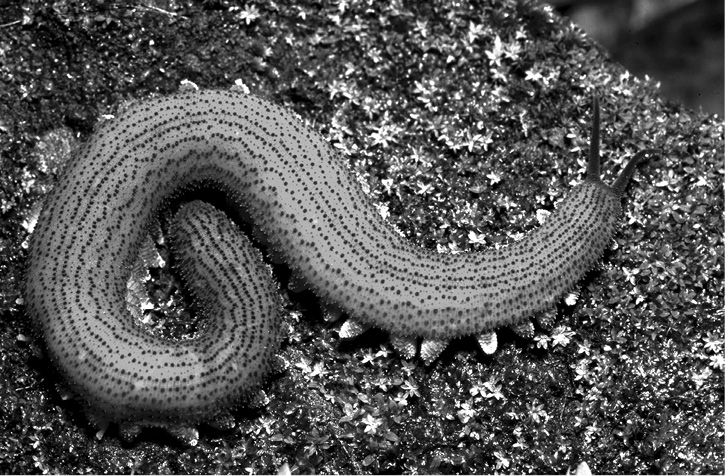
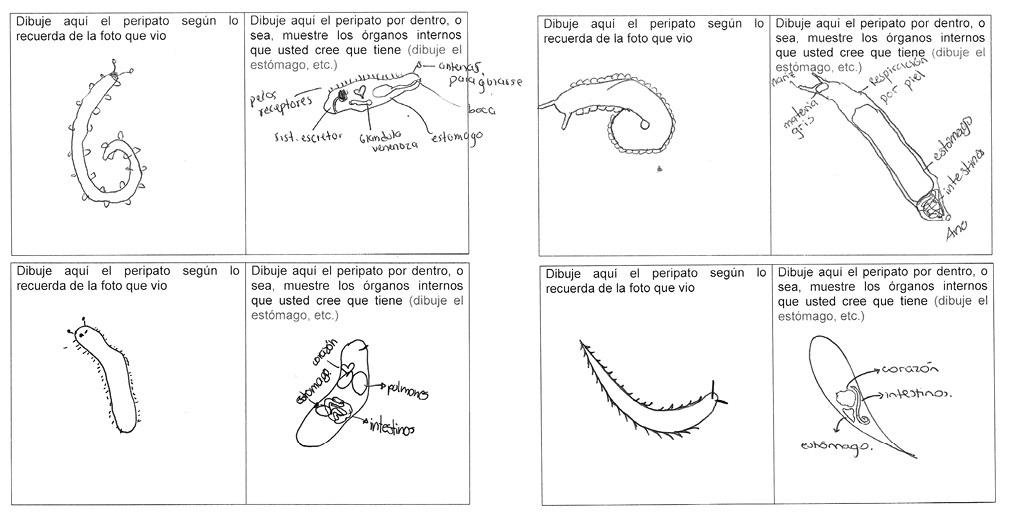
Fig. 2. Sample of drawings produced by the respondents.
Fig. 3. Relationship between pet ownership, and education, on perception of the worm. Chi Squared=18,3; p=0,0001.
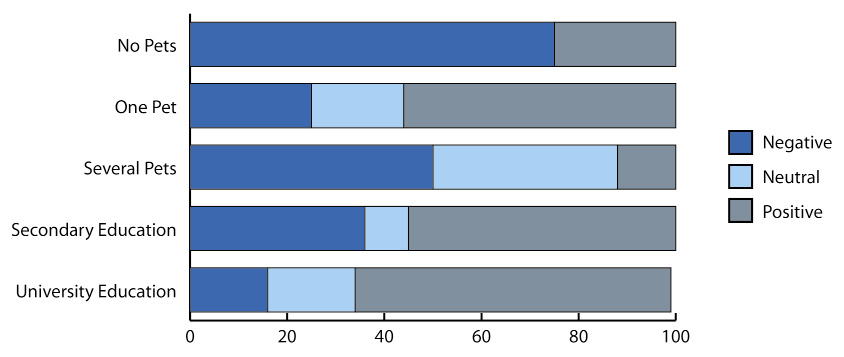
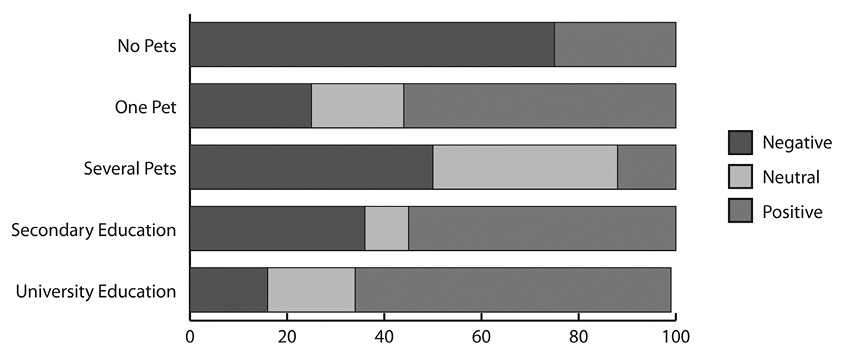
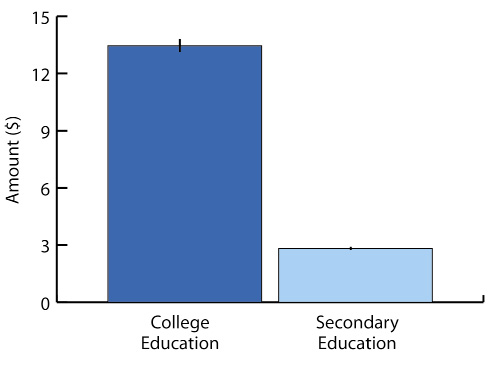
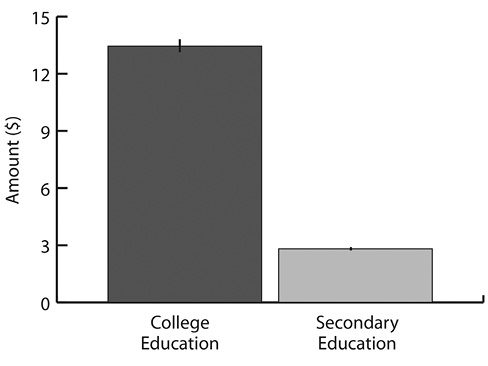
Fig. 4. Mean amount that respondents declare they would donate to conserve the worm; bars: standard error (Mann-Whitney U Test; p<0.0001).
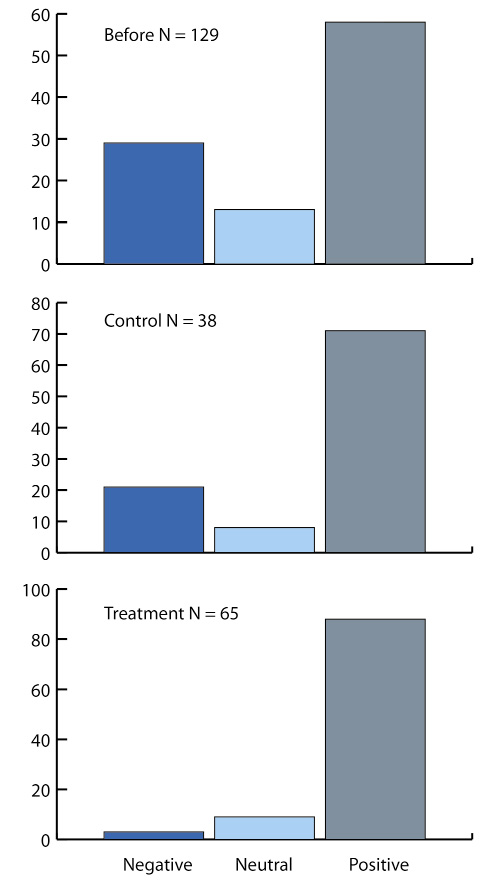
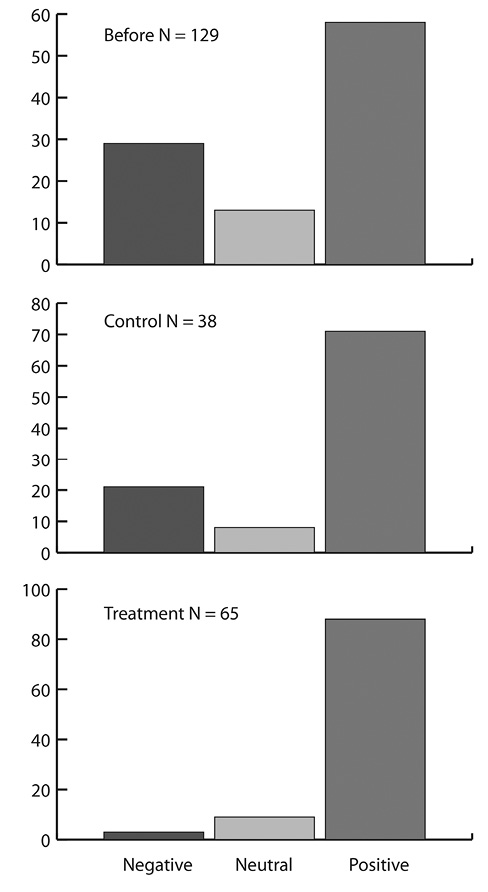
Fig. 5. Effect of five minute lecture on the perception of the worm, before receiving any lecture (whole group), and after receiving a five minute lecture on other topic (control group) or about the natural history of the worm (treatment group).
EDITED BY Carolina Seas